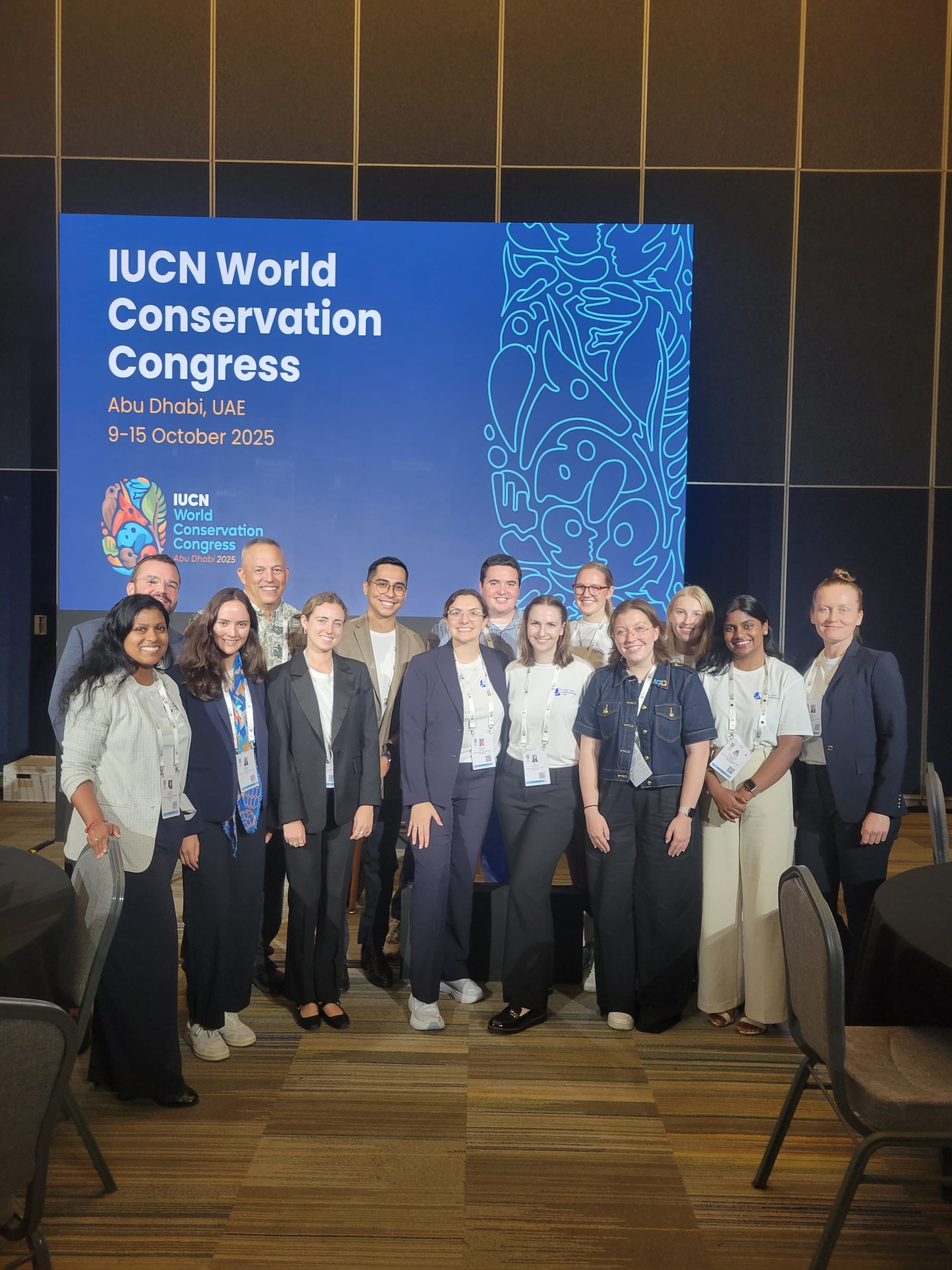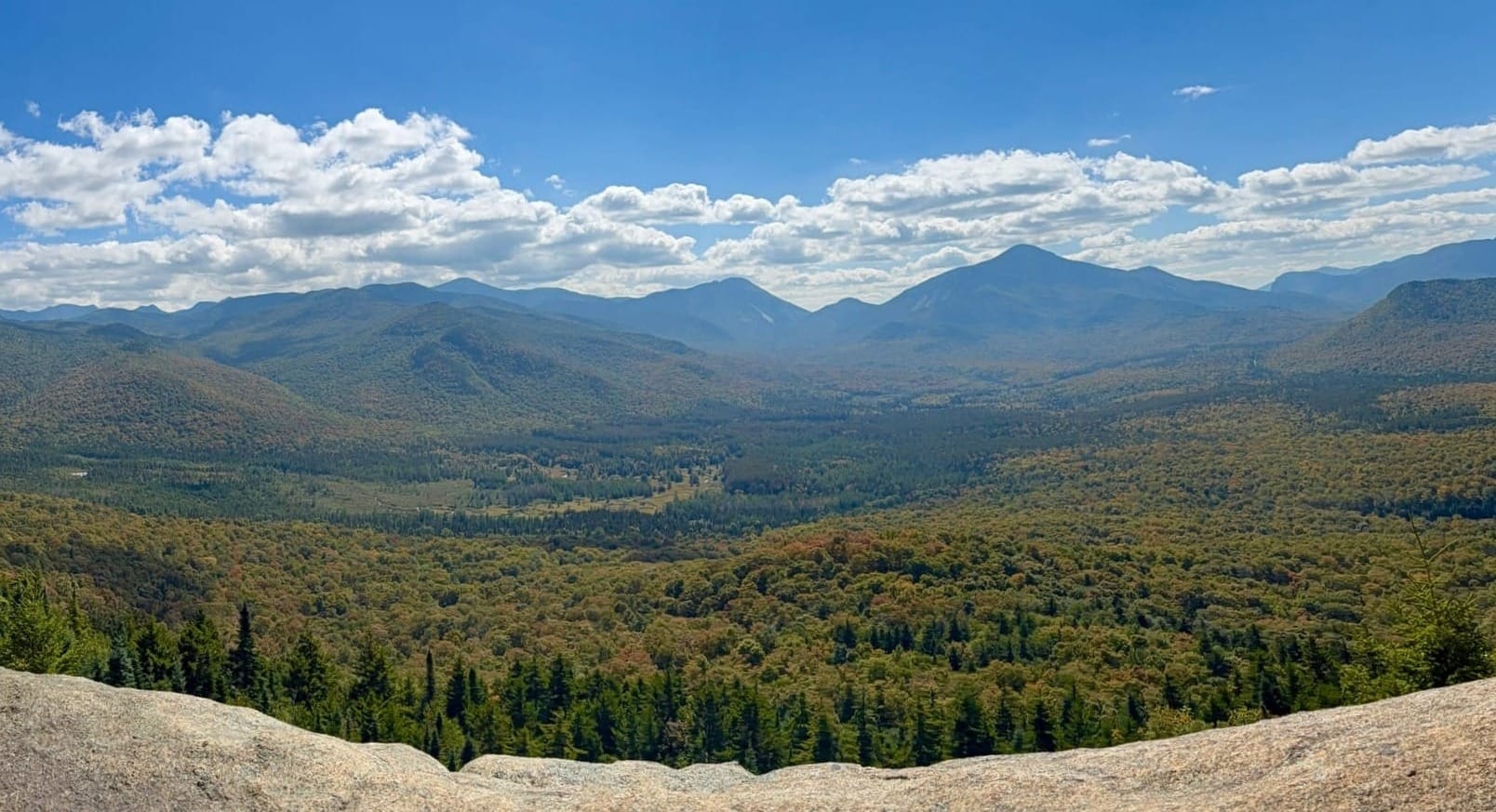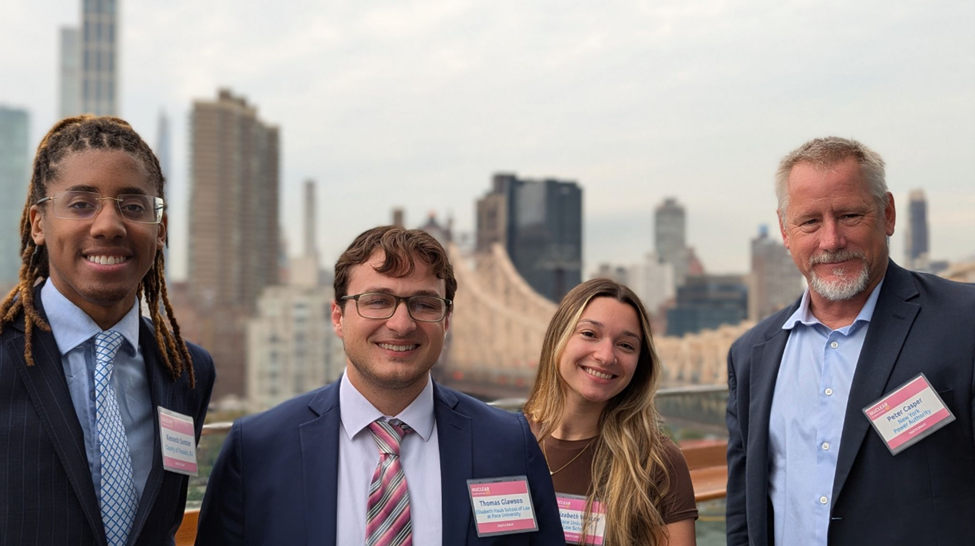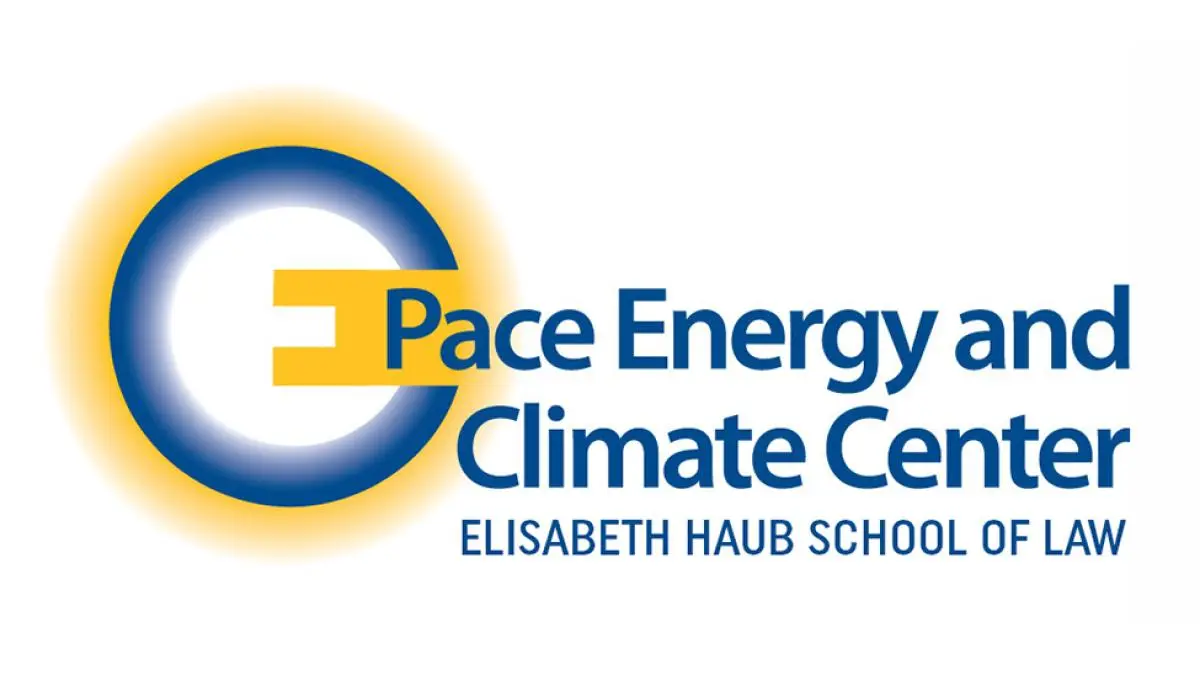Recently Attended Events
Stay informed on the latest developments in energy and environmental law through PECC's participation in key conferences, summits, and workshops. This page highlights events attended by PECC and its members, providing concise recaps of the most important discussions, debates, and takeaways for our readers.

IUCN World Conservation Congress
By: Madison Routledge Pettus | Contributors: Francesca Gugino, Harrison Bench, Victoria Sawchuk, and Lara O’Callaghan | Editors: Carington Lowe and Frances Gothard
On October 9–15, PECC Executive Director, Michael Hamersky, joined several Haub Law professors, alumni, and students in Abu Dhabi, United Arab Emirates, to convene the International Union for the Conservation of Nature (“IUCN”) World Conservation Congress (“WCC”) held every four years. The WCC was attended by over 1,400 IUCN members from over 140 countries. Through forums, exhibitions, and the Members’ Assembly, members celebrated the IUCN’s collective and individual successes, engaged in information and resource sharing, facilitated and strengthened conservation networks and collaboration, and drove the IUCN programme forward for the next four-year period. Under the leadership of Her Excellency Razan Khalifa Al Mubarak and IUCN Director General, Dr. Grethel Aguilar, the WCC facilitated the first-ever World Summit of Indigenous Peoples and Nature and saw the adoption of the 20-year Strategic Vision and a new programme for the next four-year period.
Haub Law made a notable contribution to the WCC, which involved the culmination of years of work and preparation, with many participants beginning their journey in the classroom by drafting, negotiating, and defending motions to be considered by the WCC under the guidance of Professor Achinthi Vithanage. This foundation enabled Haub Law students and alumni to engage deeply in the legislative and collaborative processes of the IUCN.
As one of only two schools with voting membership in the IUCN, Haub Law provides its students and alumni with an exceptional opportunity to participate directly in shaping international environmental policy. For many, this experience was transformative, influencing their lives and careers for years to come. Distinguished Haub Law alumnus, Madison Routledge Pettus, stated that she “was filled with pride witnessing the ways that minds from Haub Law are at the forefront of driving climate action globally. Truly, Pace has internationally recognized climate expertise.”
As a recent graduate eager to pursue a career in international environmental law, the WCC was a transformative experience for Madison, who is currently the assistant Law Clerk to the Honorable Justice Linda Christopher of the New York Supreme Court. The WCC offered exposure to sessions hosted by leading experts across diverse topics and provided endless networking opportunities with leaders and youth making remarkable strides in conservation. Beyond the business cards (and Dubai chocolate), Madison returned to New York with three significant reflections that shaped her perspective on environmental work.
First, impactful environmental work doesn’t require full-time employment. A large part of IUCN experience revolved around networking—educating people less familiar with her motion’s issue, promoting the vision behind her motion, and securing support. Through these conversations, Madison discovered that many influential contributors in the field do not hold full-time conservation roles. Yet, they fueled boots-on-the-ground conservation and made huge differences in their communities in volunteer roles as researchers, community activists, and mentors. Despite working in unrelated fields during traditional work hours, many have committed their lives to combat climate change, biodiversity loss, and pollution.
Second, there is space for students and young professionals in the international conservation arena. Following graduation, Madison began a conventional clerkship despite her desire to land a legal position in the UN secretariat or with a major environmental law firm in which she could directly advocate for environmental protections. The reality is that while it is challenging to secure traditional environmental roles as a young professional, her experiences at the WCC and Haub Law illuminate a path to participation. For those willing to be pioneers, to balance side projects, research, write outside of primary employment, and volunteer with nonprofits and networks like the IUCN, Madison is hopeful that it is possible to forge a career in environmental law. Madison met numerous young people who entered the field, not for prestigious titles, but out of genuine passion for the work—whether their interests lay in soil bacteria or mangroves. While the employment opportunities can appear elite, international environmental law is an inclusive space for all voices, even young professionals.
Third, there is real hope for the future. Despite prevailing narratives of urgency and concern about insufficient progress in combating climate change, Madison left the WCC with a renewed sense of hope. While the scientific outlook is sobering and the consequences of inaction are existential, there is also an uplifting narrative shared by professors and lifelong practitioners: this work is for future generations, and significant progress is being made. Through attending awards ceremonies and hearing distinguished panelists, Madison experienced the profound realization that environmental protections have come so far. In just fifty years, environmental law has evolved into a well-established discipline with law school curriculum, thousands of practitioners, countless court opinions, tens of treaties, and growing momentum. Madison has real hope that in her lifetime, she will see an expansion in this field and a change in culture. She cannot wait to be a part of it.
Francesca Gugino, a current Haub Law student who is in the joint degree program with Yale School for the Environment, where she is studying for her master’s in environmental management, was also a key participant in the WCC. Her interest in clean energy stems from her work with Dean Emeritus Richard Ottinger. As one of Dean Ottinger's research assistants, she was able to explore the inefficiency of implicit and explicit fossil fuel subsidies as well as existing and potential legal frameworks to push for the elimination of these subsidies.
At the IUCN WCC, Francesca was able to utilize this knowledge to support Motion 042: Addressing the climate and biodiversity crises through fossil fuel supply-side measures and a just transition. Attending contact groups regarding Motion 042 and engaging with stakeholders expanded her knowledge and deepened her understanding of international approaches to climate governance, equity, and the pathways toward a just transition. These encounters also informed her of the Fossil Fuel Non-Proliferation Treaty, which aims to complement the Paris Agreement by promoting a global phase-out of fossil fuel production and supporting a fair and equitable transition for all communities. Ultimately, Motion 042 was approved, which is a critical step in the right direction to reform the energy sector.
Harrison Bench, also a current Haub Law student who is in the joint degree program with Yale School for the Environment, where he is studying for his master’s in environmental management, reflected on his experience at the WCC, stating that “[he] had an incredible experience at last month’s IUCN WCC. It was an inspiring and engaging week filled with forum sessions, contact groups, meetings of the members’ assembly, and educational workshops, including GCELS’ ‘From Classroom to Congress’ session. The highlight of his experience was addressing the IUCN President and Director-General on the implications of the International Court of Justice’s advisory opinion on climate change for accelerating the global energy transition, and he was pleased that GCELS’ motion on the ICJ advisory opinion passed with flying colors. Through both formal sessions and youth engagement dialogues, [he] saw firsthand how forums like the WCC empower the next generation to drive renewable energy innovation and strengthen international collaboration on climate and conservation solutions.”
Haub Law advanced a diverse set of motions at the WCC. For example, Victoria Sawchuk and Lara O'Callaghan drafted and submitted a motion to the IUCN 2025 focused on strengthening the linkages between zoonotic risks and conservation efforts. Their motion later merged with proposals from the Wildlife Conservation Society, Société Française pour le Droit de l'Environnement, and Margaret Pyke Trust, resulting in two key motions advancing the One Health approach (Motion 098: the One Health approach for biodiversity, health, and global cooperation; Motion 099: the Implementation of the One Health approach, from global to local). Both motions were adopted by IUCN members during the electronic vote ahead of the WCC.
Disruptions of ecosystems, loss of biodiversity, and climate change create more disease-prone landscapes and increase human exposure to pathogens. The One Health approach recognizes the interconnectedness of human, animal, and environmental health to support both prevention and treatment. Thus, in drafting Motions 098 and 099, they sought to advance the implementation of the One Health approach through enhanced cross-sector collaboration and integrated action, recognizing that initiatives such as addressing climate change and transitioning to clean energy can concurrently mitigate zoonotic risks. Moreover, Motion 099 calls on government agencies to consider zoonotic disease risks in future development projects, including those involving energy infrastructure, as such expansion can heighten human-animal interactions and thereby increase the risk of zoonotic disease emergence.
Through the work at the WCC, Haub Law and PECC actively shaped the IUCN agenda. And, through the implementation of these resolutions, Haub Law students and alumni will continue to play a leading role in the progressive development of international environmental law for years to come.
Wind Power and Battery Storage at NYSBA Environmental & Energy Law Section
By: Carington Lowe | Editor: Frances Gothard
On September 15–16, 2025, PECC Executive Board members Carington Lowe and Frances Gothard attended the NYSBA Environmental & Energy Law Section's 2025 Fall Meeting, where they networked with environmental and energy law attorneys from across New York, including Pace Haub Law alumni, and kicked off the event with a hike up Mt. Hoevenberg for a breathtaking view.

The meeting featured several engaging panels on environmental and energy law issues, including "Wind Power and Battery Storage: Regulatory and Permitting Issues Amid Evolving Federal Energy Policy," moderated by Pace Law School alum John Parker, along with panelists Joshua Verleun, Ekin Senlet, and David Magid. The panel started by providing a much-needed perspective on the renewable energy transition, highlighting the massive amount of carbon dioxide presently in our atmosphere and the rate at which temperatures have begun rapidly increasing. After establishing this starting point, the panel moved into addressing the, not so far off, “emission-free” or “net-zero” goals that are often tossed around. After addressing our starting point and the place we need to be, the panel moved into a discussion on the use of battery power. As of 2024, the leading states in battery storage were Texas and California. However, the focus of this panel was on New York’s emergence into the use of battery storage and the public concern, including potential fire and safety hazards, that have resulted in push back in areas of the state such as Long Island. Nonetheless, these batteries serve as critical components of renewable energy projects.
However, public misperception is not the only barrier to battery storage. Both battery storage and renewable energy projects, such as wind farms, are experiencing major delays as a result of permitting changes at the federal level. Although permitting challenges are not new for renewable energy development, projects just starting out, particularly offshore wind, are not just losing momentum but coming to a complete halt. Even projects that were already underway and had obtained permits prior to these federal changes are being impacted as they receive stop-work orders. As policy changes continue, they create a lack of uniformity, leading those managing these projects in a difficult spot where they must be ready to adjust. What does this mean for the lawyers who represent and advise these clients? Well, you have to be creative and think about all of the ins and outs of the project. This includes asking your clients questions they may not even be able to answer, such as where they are sourcing their products, when they expect to break ground, and what the project’s "energy density" is. Vague answers will no longer suffice.
The panel ended on a slightly, and unexpectedly, lighter note—funding. Incentives are dwindling but they are still out there. Developers have to be ready to hit the ground running, adjust at the drop of a hat, and be ready to take on these “shorter runways” for funding, despite the uncertainties they are bound to face. The march toward renewable energy, and preventing the transmission bottleneck by implementing battery storage, will continue on!
Earth Law Center ECO Summit
By: Kenneth Sumter | Editor: Carington Lowe
The Earth Law Center ECO Summit at Fordham Law School brought together current and future legal scholars, advocates, and environemental leaders. The event focused on the exploration of the Green Amendment, Art. I, Sec. 19 of the New York Constitution, which affirms every person's right to a healthy environment. Attendees were encouraged to think beyond traditional approaches to environmental law, embracing a paradigm shift from treating nature as mere property to recognizing it as a rights-holder with intrinsic value. This perspective challenges the anthrocentric frameworks of the past, promoting an integrated approach centered on ecological well-being.
The summit also examined Panama's Rights of Nature law, which incorporates principles like in dubio pro natura—favoring nature when legal outcomes are uncertain. A notable case before Panama's Supreme Court highlighted both the promise and the limitations of this approach: the court temporarily halted a highway project in a private reserve under the precautionary principle but refused a full suspension because the harm was not yet "imminent." This outcome underscores a critical gap: if courts wait for visible damage, the law's ability to prevent environmental destricution is compromised. Enforcement challenegs further highlight a persistent principle, personal experiences shape legal outcomes. For example, judges who grew up with parrots as pets were hesitant to enforce bans on parrot ownership, despite the law's goal of protecting the species from potential extincition.
Speakers also explored how Rights of Nature laws worldwide could evovled to better incorporate precautionary princioles. Cat Haas, director of ECO Jurisprudence Monitor, shared how existing rights-of-nature frameworks in various countries establish environmental personhood and could be developed to anticipate harm more proactively. Architect Amanda Sturgeon, CEO of the Biomimicry Institute, emphasized the potential for cities to transition their “lazy leftover spaces,” created by highways, parking lots, or grey infrastructure, into green systems that work with nature.
Eric Sanderson, Vice President for Urban Conservation & Director of the Center for Conservation and Restoration Ecology for the New York Botanical Garden, highlighted the intersection of ecological and social justice by noting the vast number of New York City urban spaces that are layered over histories of injustice, including slave burial grounds, displacement of Indigenous peoples, and polluted neighborhoods. He argued that ecological and social justice are inseperable and proposed creating public spaces to honor and make homage on the land before us through historic signage that will foster public reflection.
Causeway & COPx Catalysts for Global Change
By: Kenneth Sumter | Editor: Carington Lowe
The Causeway & COPx Catalyst for Global Change conference shifted my perspective on climate solutions in a powerful way. The central message was simple yet profound: climate action isn’t a sacrifice; it’s an opportunity to strengthen humanity. I have heard that phrase before, but hearing it unpacked by so many diverse speakers made it real for me.
Two solutions were emphasized again and again: stop greenhouse gas emissions from fossil fuels, and draw down excess CO₂ through regenerative agriculture. I was moved by how these aren’t just technical fixes; they are also pathways for small farmers to thrive. Farming done in harmony with the land not only heals the climate but also lifts up communities. This struck me how often climate debates get framed as losses or trade-offs, when in reality they can be faster, cheaper, and ways to build resilience.
One speaker framed it as giving power back to people when governments fail. Change doesn’t always start at the top; it often begins with everyday acts of resistance and care. The phrase “find your dot” stuck with me: the idea that every day, if we can do & focus on one thing; just one small act can have the power to connect us to a bigger movement.
I was especially inspired by the story of the international supermodel in Paris who wrote The Water Princess, a children’s book based on her own experience of watching her pregnant sister walk three hours for water in Africa. That book grew into her creation of the Oasis program, which now provides clean water, toilets, gardens, and electricity for her African community. Her story reminded me of the power that personal storytelling can transform pain into collective action.
The panel speaker whose topic was on brain health was unexpected but eye-opening in how that brain health is affected by climate. The neurologist explained that brain illness is the largest global health crisis, however prevention is possible through lifestyle changes and a clean environment. Our brains literally depend on clean air, green space, and a stable climate. I previously never associated climate risk towards brain activity that possibly induce depression, anxiety, and dementia but now I can’t unsee the connection. Protecting nature is also protecting the very organ that makes us human, our brains.
The panel delivered hopeful examples about the power of biodiversity. Projects in the Amazon, where indigenous communities develop biodiversity credits; coral growing initiatives in Indonesia; and youth movements like GenZ.org that empower millions of GenZ’rs to take action for the oceans or at least learn who in our generation are taking action. Each example felt like a spark of light in the enormity of the climate crisis.
I struck a nerve by the honesty of the speakers that collectively admitted that capital is still essential to be a deliverance against the climate crisis. No solution can scale without financing. Through this lens, however, utilizing capital to align with climate resilience, whether it’s supporting women’s health research, protecting forests, or creating causeway platforms for NGOs, it can seed profound change.
The most powerful reminder came near the end with a bold declaration. Women hold communities together, especially amidst a climate crisis. I clearly believe that women’s health and earth’s health are bound together. Women carry knowledge and stability across all generations.
Leaving the room, I felt both humbled and energized. Climate law is not just about carbon metrics or regulatory frameworks. It’s about dignity, resilience, and survival. It’s about women carrying water, indigenous communities protecting jaguars, youth demanding oceans free of plastic, and neurologists reminding us that our brains are at risk if we do nothing.
What stays with me is this sense of interconnectedness: climate action is not sacrifice. It’s the deepest form of care; for each other, for our bodies, for our minds, and for the planet itself.
The 2025 Nuclear Symposium Accelerating Clean Energy Innovation at Cornell Tech Campus on Roosevelt Island
By: Kenneth Sumter | Editor: Carington Lowe
Attending the 2025 Nuclear Symposium Accelerating Clean Energy Conference at Cornell Tech Campus on Roosevelt Island was both eye-opening and overwhelming. This conference covered Nuclear Energy and how AI can be incorporated to expedite the permitting process. I came into the conference expecting a technical conversation about power grids, however what I experienced was a sweeping exploration of AI’s potential to expedite nuclear infrastructure permitting documents to secure approval regulation at a faster than industry normal rate.
The speakers emphasized that the “real” cost of wind and solar often looks more affordable when actual grid use is factored in. However, the growing demand from AI complicates that narrative. I found myself asking the same question the panelists posed: is power demand from AI truly real, or are we still trying to measure it? The sense of urgency was palpable. AI’s exponential demand for energy may be driving a transition that is no longer hypothetical but undeniably present. In other words, this is real, and AI is here to stay.
One idea that caught my attention was whether we could bring energy production closer to data centers, essentially redesigning nuclear infrastructure around AI itself. This made me reconsider traditional industrial supply chains and their inefficiencies. If the “new economy” is going to revolve around AI models, then energy logistics, whether through e-commerce, distribution centers, or entirely new kinds of plants must adapt.
The nuclear case studies discussed, most notably Vogtle Units 3 and 4 in Georgia, were litigated amongst the speakers during the conference. That project ballooned from an estimated completion cost of $14 Billion in 8 years to $32 billion in actual completion of the plants and took 15 years. An almost miraculous completion given bankruptcies, management failures, and regulatory delays. The lesson repeated again and again that nuclear energy doesn’t fail because of technology, but because of management, financing, and regulatory bottlenecks. That reflection made me question whether AI could step in to predict construction pitfalls, streamline licensing, and manage documentation more efficiently. If AI can assist in reconciling regulatory documents or accelerating licensing reviews, maybe it could have assisted to avoid the mistakes that haunted Vogtle and the nuclear industry experts.
The licensing process itself fascinated me. It rests on thousands of technical documents, subject matter expertise, and the back-and-forth with regulators and industry stakeholders on a project. AI’s role here could be transformative: not as a substitute for human judgment, but as a tool for consistency and transparent tracking. Microsoft’s involvement in AI-driven licensing solutions for the nuclear industry felt almost surreal. A tech company is potentially reshaping the most bureaucratic part of nuclear regulatory schemes.
What stood out for me were the socio-economic dimensions. Nuclear plants are not just energy producers; they are job creators, tax bases, and community anchors. Oswego County Administrator stood grounded with passion to exclaim to the audience that nuclear power has beautifully shaped the identity of their entire region for decades and they want more nuclear plants to be built. This puts a human face on the issue surrounding nuclear plants. Communities that live with these plants, benefit from their jobs within the plant, and struggle with their closures. I start to connect that law and policy must grapple not only with emissions or kilowatts but also with pensions, tax agreements, and workforce transitions.
Perhaps the most striking takeaway was how trust underpins everything. Trust in regulators, in financing models, in technology, and in communities themselves. Without trust, investors hesitate, regulators delay, and communities resist. With trust, new financing models like Finland’s patient capital approach and workforce transitions such as coal workers moving into nuclear through community programming become possible.
Walking out of the conference, I considered the following: the nuclear industry may not suffer from a technology deficit; but from a management and governance deficit. As a law student, I see the challenge not only as one of energy policy but also of legal frameworks, licensing regimes, and community relations. The intersection with AI makes this even more complex however more exciting to address and provide sound solutions. Could AI provide the “active ingredient” missing in project management and regulatory consistency? Could it help reconcile the massive gap between surging AI energy demand and sluggish nuclear project delivery?
For me, this conference wasn’t just about energy. It was a network opportunity where I connected with the New York Power Authority and my fellow colleagues from Pace Haub Law to discuss how we interpreted this year’s nuclear conference during the network reception.

Upcoming Events
- 11/10–12: Land Use Leadership Alliance Training – Hudson Valley
- 11/9–16: 2025 United Nations Climate Change Conference in Belem, Brazil
- 11/12–13: A Mandate for All: the Legal and Civic Imperative to Confront the Climate Emergency Conference - Rio de Janeiro, Brazil | New York, U.S. | Online
- PECC is honored to participate in a prominent international event, promoted by FGV Direito Rio, the Elisabeth Haub School of Law at Pace University, and the World Commission on Environmental Law. Executive Director Michael Hamersky will moderate the Networking to Magnify Effectiveness panel, while Executive Board member Carington Lowe will serve as the youth commentator for Corporate Climate Action: Accountability and the Path to Net Zero.
- 12/11: The Future of Utility Regulation 2025 – Managing Competition Symposium, NYC
